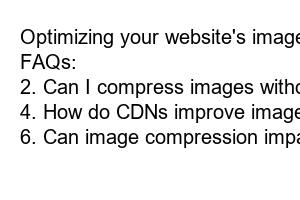사진 용량 줄이는 법
Title: How to Reduce Photo Size: Simple Tips for Efficient Image Compression
Introduction:
In today’s digital era, visual content has become an integral part of our online lives. However, large photo sizes can significantly impact website loading times, impede user experience, and even consume excessive storage space. Fortunately, reducing photo size can help optimize your website’s performance without compromising on image quality. In this article, we will guide you through simple techniques to effectively compress images, ensuring a seamless user experience.
1. Choose the Right Image Format:
Selecting the appropriate image format is crucial to achieve a balance between size reduction and picture quality. While JPEG (Joint Photographic Experts Group) is ideal for photographs, PNG (Portable Network Graphics) format is preferred for graphics and transparent images. Familiarize yourself with the strengths of each format to optimize your image compression efforts.
2. Resize Images to Fit the Display:
Before uploading to your website, it is essential to resize your images according to the required dimensions. Avoid resizing images using HTML or CSS codes, as this does not alter the actual file size. Instead, **use image editing software** or online tools to resize and scale your images precisely, reducing their filesize and display dimensions.
3. Compress Images Without Significant Quality Loss:
To maintain a balance between image quality and size reduction, consider compressing your images using specialized applications or online tools. These tools employ various algorithms capable of reducing file size without compromising on visual clarity. Optimize your images without any noticeable differences in quality by **adjusting the compression settings** according to your requirements.
4. Adopt Efficient Compression Techniques:
To further enhance your image compression, explore advanced compression techniques. Minify your images by **removing unnecessary metadata**, such as EXIF data, that may not be crucial for your website. Likewise, try **progressive image loading** to allow the image to load in stages, ensuring a more pleasant user experience as pages render faster.
5. Leverage Content Delivery Networks (CDNs):
Utilizing a Content Delivery Network (CDN) can significantly improve your website’s performance. These networks save cached versions of your site in various global locations, ensuring faster and more streamlined content delivery. By incorporating a CDN, you can **speed up image loading times** and enhance the overall responsiveness of your website.
6. Optimize Image File Names and Alt Text:
Search Engine Optimization (SEO) plays a vital role in raising your website’s visibility and driving organic traffic. As part of this optimization, **ensure that image filenames and alt text are descriptive and relevant**. This helps search engines understand your visual content, improves accessibility, and indirectly contributes to reducing photo size by streamlining image indexing.
Summary:
Optimizing your website’s images by reducing their size not only improves loading times and user experience but also enhances your site’s SEO. By following the techniques discussed in this article, such as choosing the right format, resizing and compressing images, leveraging advanced compression methods, incorporating a CDN, and optimizing image filenames and alt text, you can effectively reduce photo size without compromising on quality. Start implementing these simple yet effective practices today and unlock the true potential of your website.
FAQs:
1. What is the ideal photo size for web use?
2. Can I compress images without losing quality?
3. Are there any tools that can automate the image compression process?
4. How do CDNs improve image loading times?
5. Should I use JPEG or PNG format for my website’s logo?
6. Can image compression impact my website’s SEO ranking?

